A Preliminary Investigation into Separating Performance and Magnetic Field Characteristic Analysis Based on a Novel Matrix
Abstract
:1. Introduction
2. Experimental
2.1. The Screw Thread Rod Matrix
2.2. A Horizontal Magnetic Field Orientation HGMS Separator and Its Principle
2.3. Sample
2.4. The Physical Testing Procedures and Conditions
2.5. Evaluation Methods of Separation Performance
3. Results and Discussion
3.1. Influence of the Distance between ERB on Separation Performance
3.2. Influence of Column Gap between Adjacent Rod Elements on the Separation Performance
4. Numerical Analysis of Magnetic Field Distribution Based on Matrix Parameters
4.1. Establishment and Optimization of the Simulation Model
4.2. Governing Equations
4.3. Mesh Generation and Defined Parameters for the Solution Process
4.4. Numerical Test Results
5. Conclusions
Acknowledgments
Author Contributions
Conflicts of Interest
References
- Wills, B.A.; Napier-Munn, T.J. Mineral Processing Technology, 7th ed.; Elsevier Science & Technology Books: Amsterdam, The Netherlands, 2006. [Google Scholar]
- Svoboda, J.; Fujita, T. Recent developments in magnetic methods of material separation. Miner. Eng. 2003, 16, 785–792. [Google Scholar] [CrossRef]
- Chen, L.Z.; Xiong, D.H.; Huang, H.C. Pulsating high-gradient magnetic separation of fine hematite from tailings. Miner. Metall. Process. 2009, 26, 163–168. [Google Scholar]
- Newns, A.; Pascoe, R.D. Influence of path length and slurry velocity on the removal of iron from kaolin using a high gradient separator. Miner. Eng. 2002, 15, 465–467. [Google Scholar] [CrossRef]
- Karapinar, N. Magnetic separation of ferrihydrite from wastewater by magnetic seeding and high-gradient magnetic separation. Int. J. Miner. Process. 2003, 71, 45–54. [Google Scholar] [CrossRef]
- Svoboda, J. A realistic description of the process of high-gradient magnetic separation. Miner. Eng. 2001, 14, 1493–1501. [Google Scholar] [CrossRef]
- Watson, J.H.P. Theory of capture of particles in magnetic high-intensity filters. IEEE Trans. Magn. 1975, 11, 1597–1599. [Google Scholar] [CrossRef]
- Baik, S.K.; Ha, D.W.; Ko, R.K.; Kwon, J.M. Magnetic field and gradient analysis around matrix for HGMS. Phys. C Supercond. 2010, 470, 1831–1836. [Google Scholar] [CrossRef]
- Song, S.; Lopez-Valdivieso, A.; Ding, Y. Effects of nonpolar oil on hydrophobic flocculation of hematite and rhodochrosite fines. Powder Technol. 1999, 101, 73–81. [Google Scholar] [CrossRef]
- Wasmuth, H.D.; Unkelbath, K.H. Recent developments in magnetic separation of feebly magnetic minerals. Miner. Eng. 1991, 4, 825–837. [Google Scholar] [CrossRef]
- Sivamoha, R. The problem of recovering very fine particles in mineral processing—A review. Int. J. Miner. Process. 1990, 28, 247–288. [Google Scholar] [CrossRef]
- Tsouris, C. Particle flocculation and filtration by high-gradient magnetic fields. Sep. Sci. Technol. 1997, 32, 599–616. [Google Scholar] [CrossRef]
- Luo, L.; Nguyen, A.V. A review of principles and applications of magnetic flocculation to separate ultrafine magnetic particles. Sep. Purif. Technol. 2017, 172, 85–99. [Google Scholar] [CrossRef]
- Song, S.; Lu, S.; Lopez-Valdivieso, A. Magnetic flocculation of hematite and limonite fines as hydrophobic flocs from iron ores. Miner. Eng. 2002, 15, 415–422. [Google Scholar] [CrossRef]
- Tsouris, C.; Scott, T. Flocculation of paramagnetic particles in a magnetic field. J. Colloid Interface Sci. 1995, 171, 319–330. [Google Scholar] [CrossRef]
- Luo, L.; Zhang, J.; Yu, Y. Recovering limonite from Australia iron ores by flocculation-high intensity magnetic separation. J. Cent. South Univ. Technol. 2005, 12, 682–687. [Google Scholar] [CrossRef]
- Škvarla, J.; Zelenak, F. Magnetic-hydrophobic coagulation of paramagnetic minerals: A correlation of theory with experiments. Int. J. Miner. Process. 2003, 68, 17–36. [Google Scholar] [CrossRef]
- Chen, L. Effect of magnetic field orientation on high gradient magnetic separation performance. Miner. Eng. 2011, 24, 88–90. [Google Scholar] [CrossRef]
- Zeng, W.; Dahe, X. The latest application of SLon vertical ring and pulsating high-gradient magnetic separator. Miner. Eng. 2003, 16, 563–565. [Google Scholar] [CrossRef]
- Stadtmuller, A.A.; Good, J.A.; Riches, N.J. Developments in superconducting magnetic separation. Ind. Miner. 1988, 3, 58–69. [Google Scholar]
- Padmanabhan, N.P.H.; Sreenivas, T. Process parametric study for the recovery of very-fine size uranium values on super-conducting high gradient magnetic separator. Adv. Powder Technol. 2011, 22, 131–137. [Google Scholar] [CrossRef]
- Kim, Y.G.; Song, J.B.; Yang, D.G.; Lee, J.S.; Park, Y.J.; Kang, D.H. Effects of filter shapes on the capture efficiency of a superconducting high-gradient magnetic separation system. Supercond. Sci. Technol. 2013, 26, 1–7. [Google Scholar] [CrossRef]
- Zhang, K.; Nieto, A.; Kleit, A.N. The real option value of mining operations using mean-reverting commodity prices. Miner. Econ. 2015, 28, 11–22. [Google Scholar] [CrossRef]
- Zhang, K.; Kleit, A.; Nieto, A. An economics strategy for criticality—Application to rare earth element Yttrium in new lighting technology and its sustainable availability. Renew. Sustain. Energy Rev. 2017, 77, 899–915. [Google Scholar] [CrossRef]
- Zhang, K.; Kleit, A.N. Mining rate optimization considering the stockpiling: A theoretical economics and real option model. Resour. Policy 2016, 47, 87–94. [Google Scholar] [CrossRef]
- Eisenstein, I. Magnetic traction force in a HGMS with an ordered array of wires: I. IEEE Trans. Magn. 1978, 14, 1148–1154. [Google Scholar] [CrossRef]
- Chen, L.; Qian, Z.; Wen, S.; Huang, S. High-gradient magnetic separation of ultrafine particles with rod matrix. Miner. Process. Extr. Metall. Rev. 2013, 34, 340–347. [Google Scholar] [CrossRef]
- Too, C.O.; Parker, M.R.; Gerber, R.; Fletcher, D. Optimisation of matrix design in high gradient magnetic separation. J. Phys. D Appl. Phys. 1986, 19, L1–L4. [Google Scholar] [CrossRef]
- Zheng, X.; Wang, Y.; Lu, D. Study on capture radius and efficiency of fine weakly magnetic minerals in high gradient magnetic field. Miner. Eng. 2015, 74, 79–85. [Google Scholar] [CrossRef]
- Chen, L.; Ding, L.; Zhang, H.; Huang, J. Slice matrix analysis for combinatorial optimization of rod matrix in PHGMS. Miner. Eng. 2014, 58, 104–107. [Google Scholar] [CrossRef]
- Zheng, X.; Wang, Y.; Lu, D. Investigation of the particle capture of elliptic cross-sectional matrix for high gradient magnetic separation. Powder Technol. 2016, 297, 303–310. [Google Scholar] [CrossRef]
- Li, Z.; Watson, J.H.P. The effect of the matrix shape on vortex magnetic separation. Miner. Eng. 1995, 8, 401–407. [Google Scholar] [CrossRef]
- Zheng, X.; Wang, Y.; Lu, D.; Li, X. Theoretical and experimental study on elliptic matrices in the transversal high gradient magnetic separation. Miner. Eng. 2017, 111, 68–78. [Google Scholar] [CrossRef]
- Li, X.L.; Yao, K.L.; Liu, H.R.; Liu, Z.L. The investigation of capture behaviors of different shape magnetic sources in the high-gradient magnetic field. J. Magn. Magn. Mater. 2007, 2, 481–488. [Google Scholar] [CrossRef]
- Ku, J.G.; Chen, H.H.; He, K.; Xu, L.; Yan, Q.X. Numerical simulation of agglomeration process dynamics of ferromagnetic mineral particles in a weak magnetic field. Int. J. Miner. Process. 2014, 133, 46–51. [Google Scholar] [CrossRef]

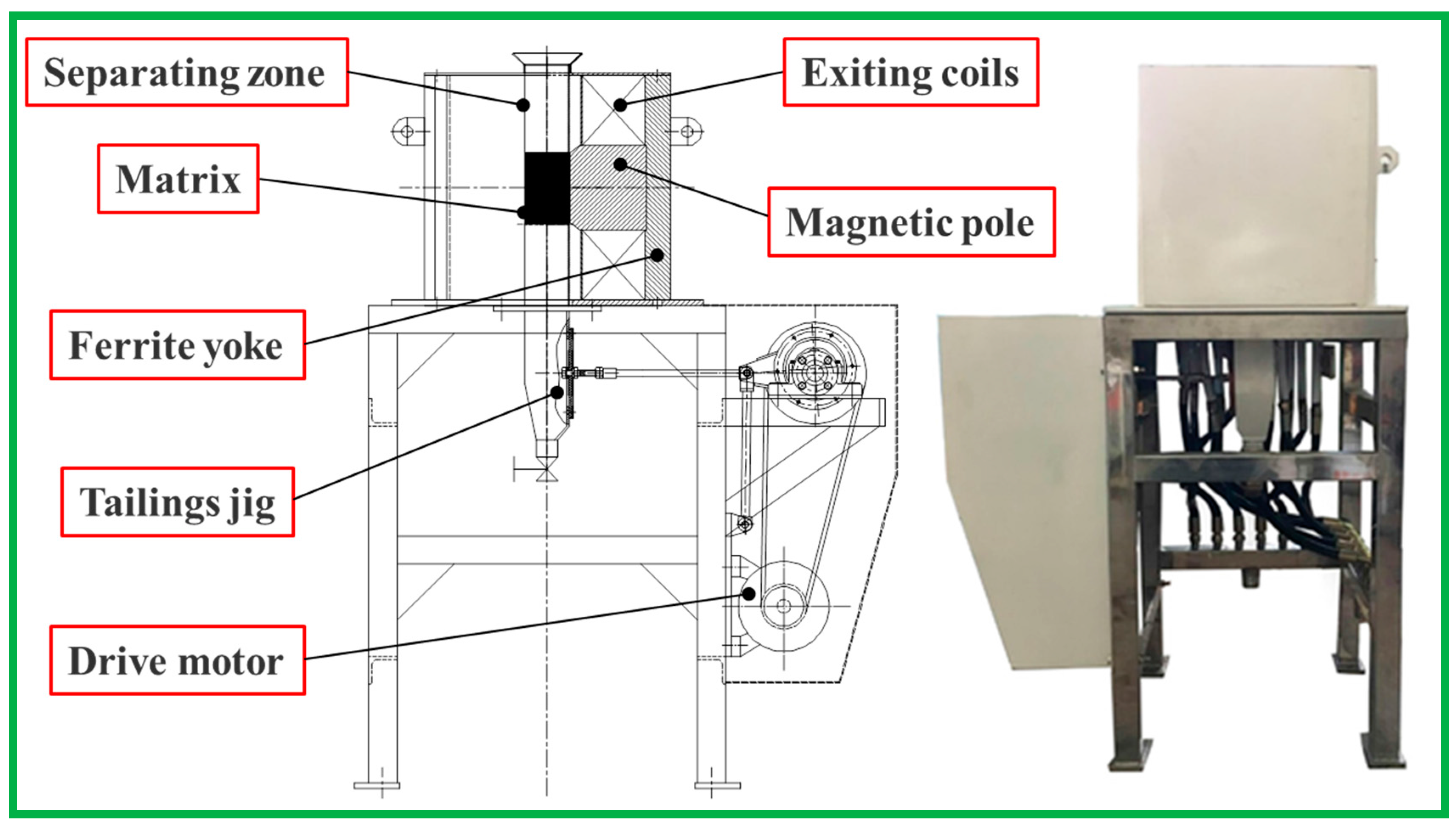

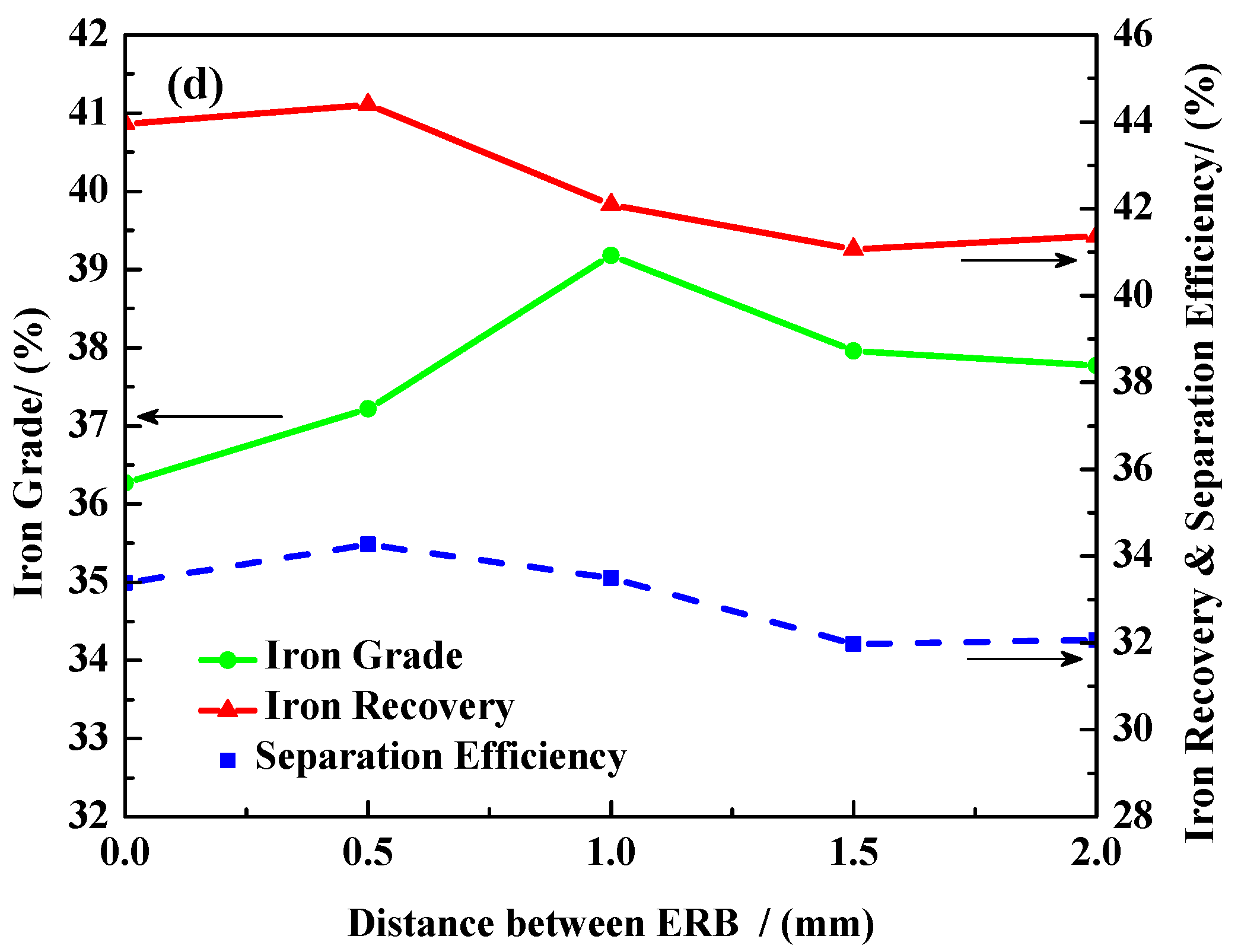

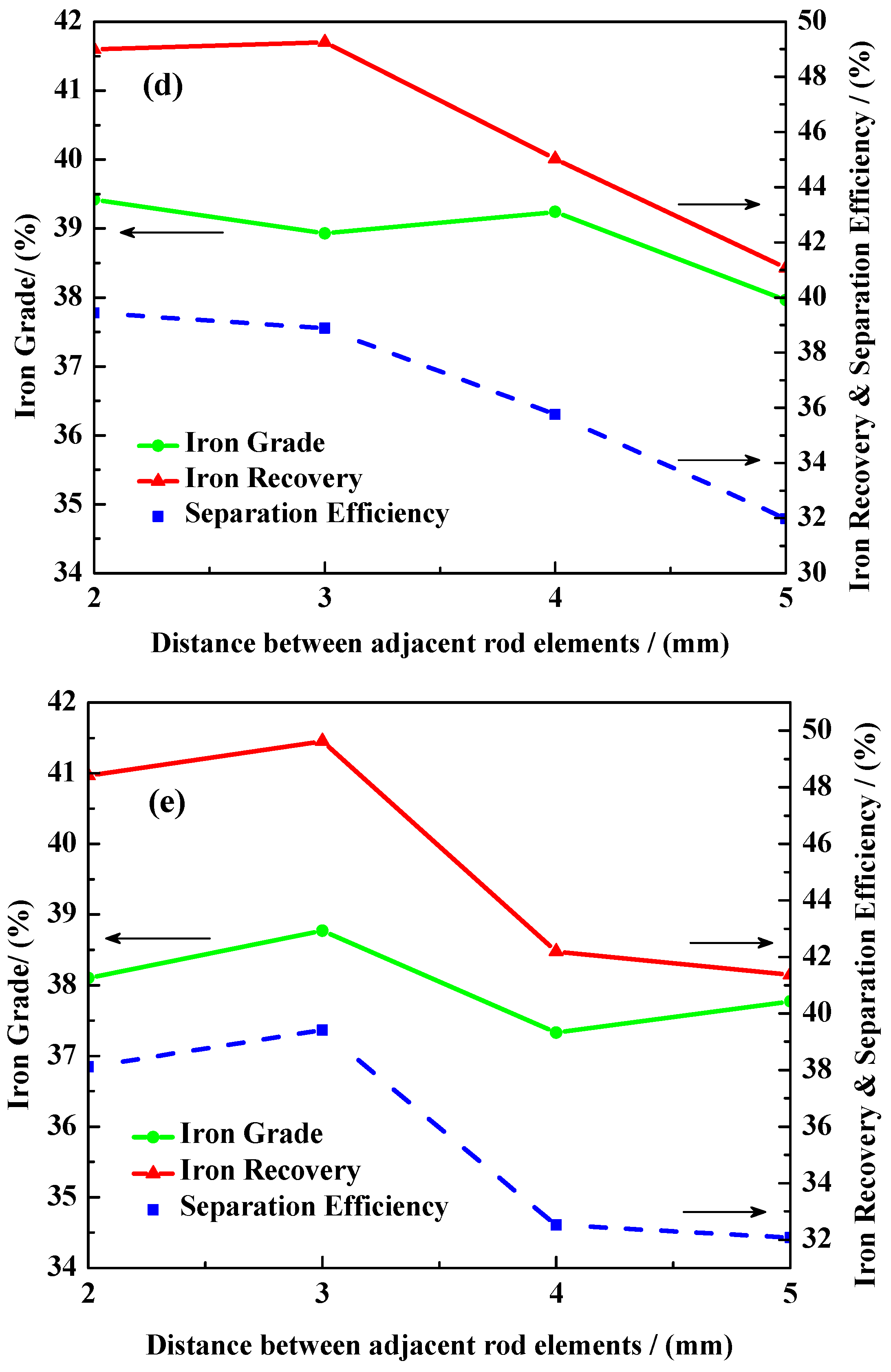
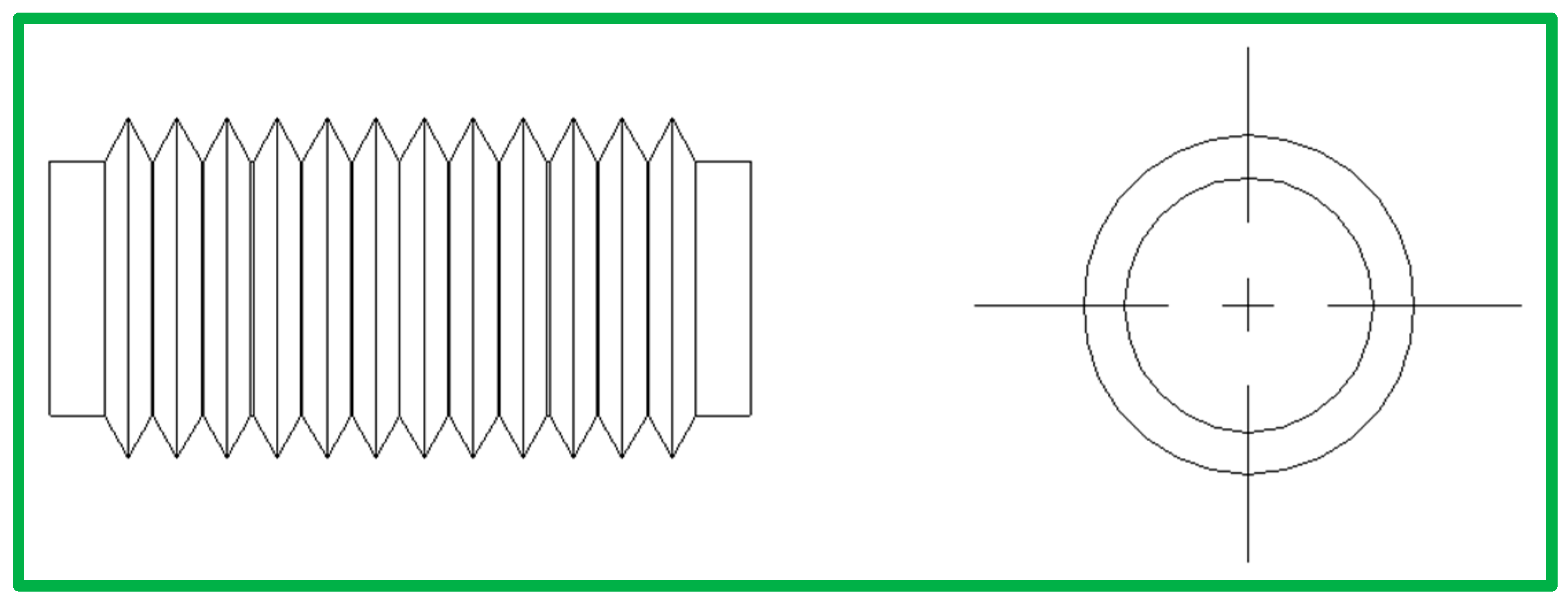
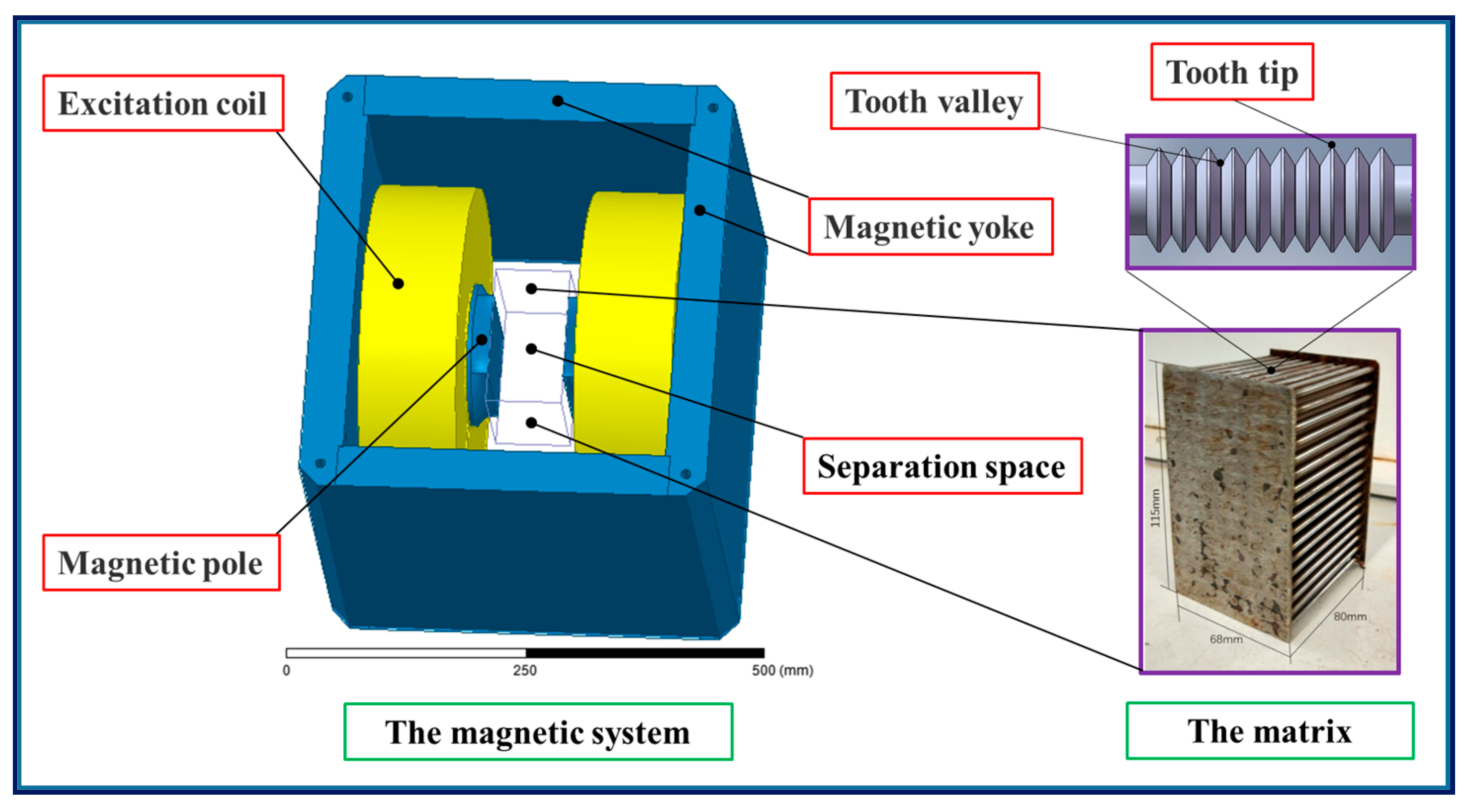
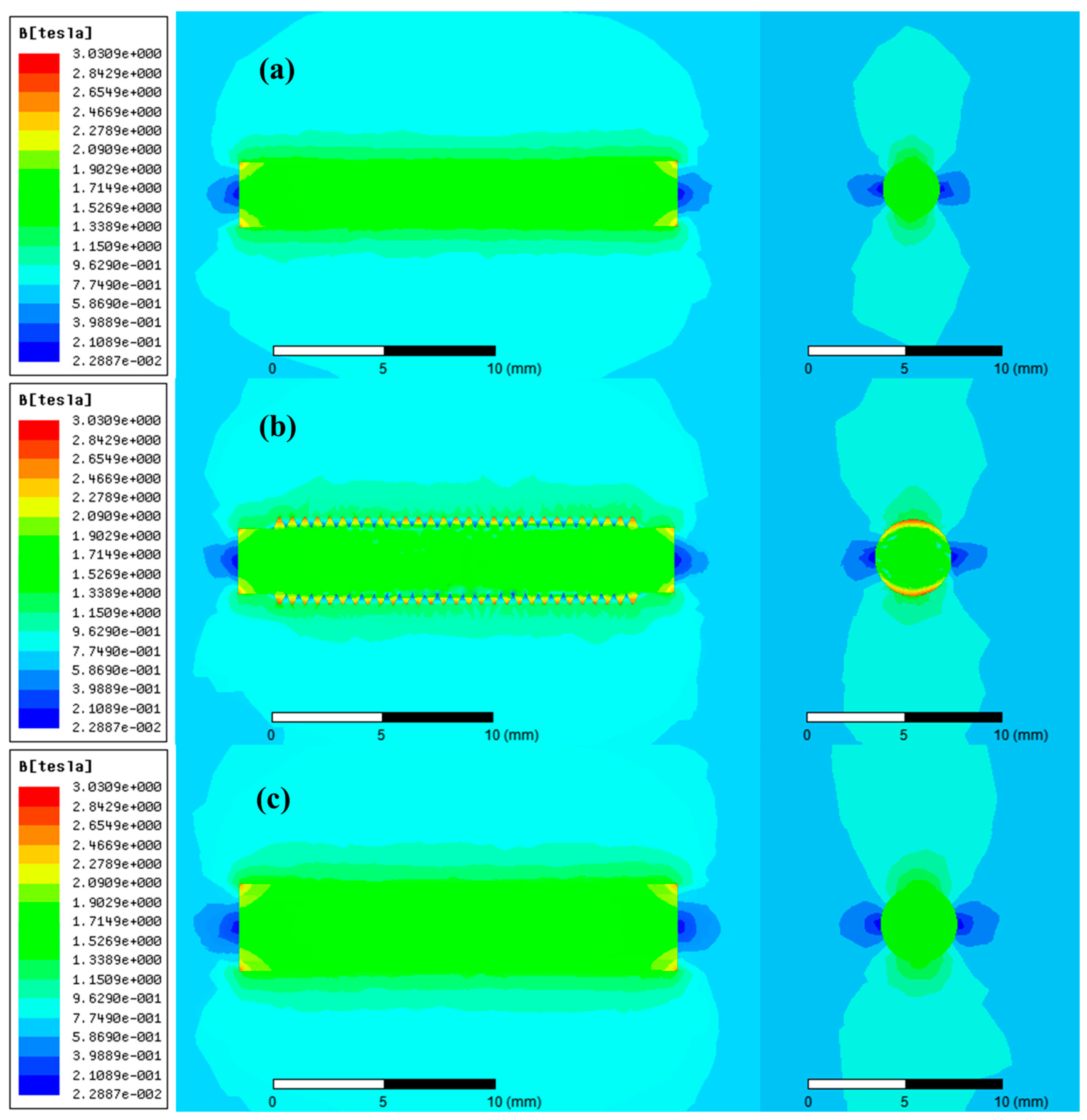
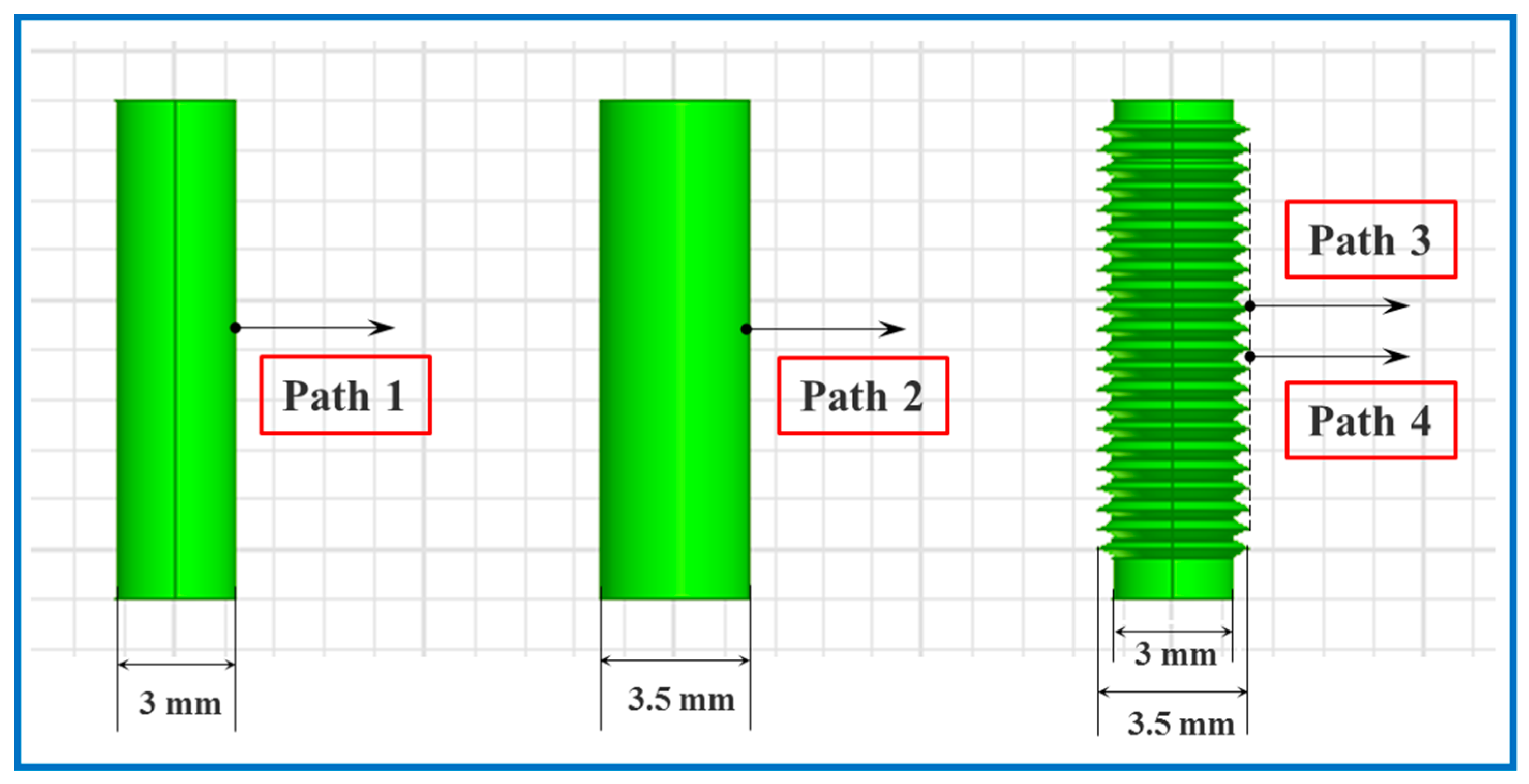
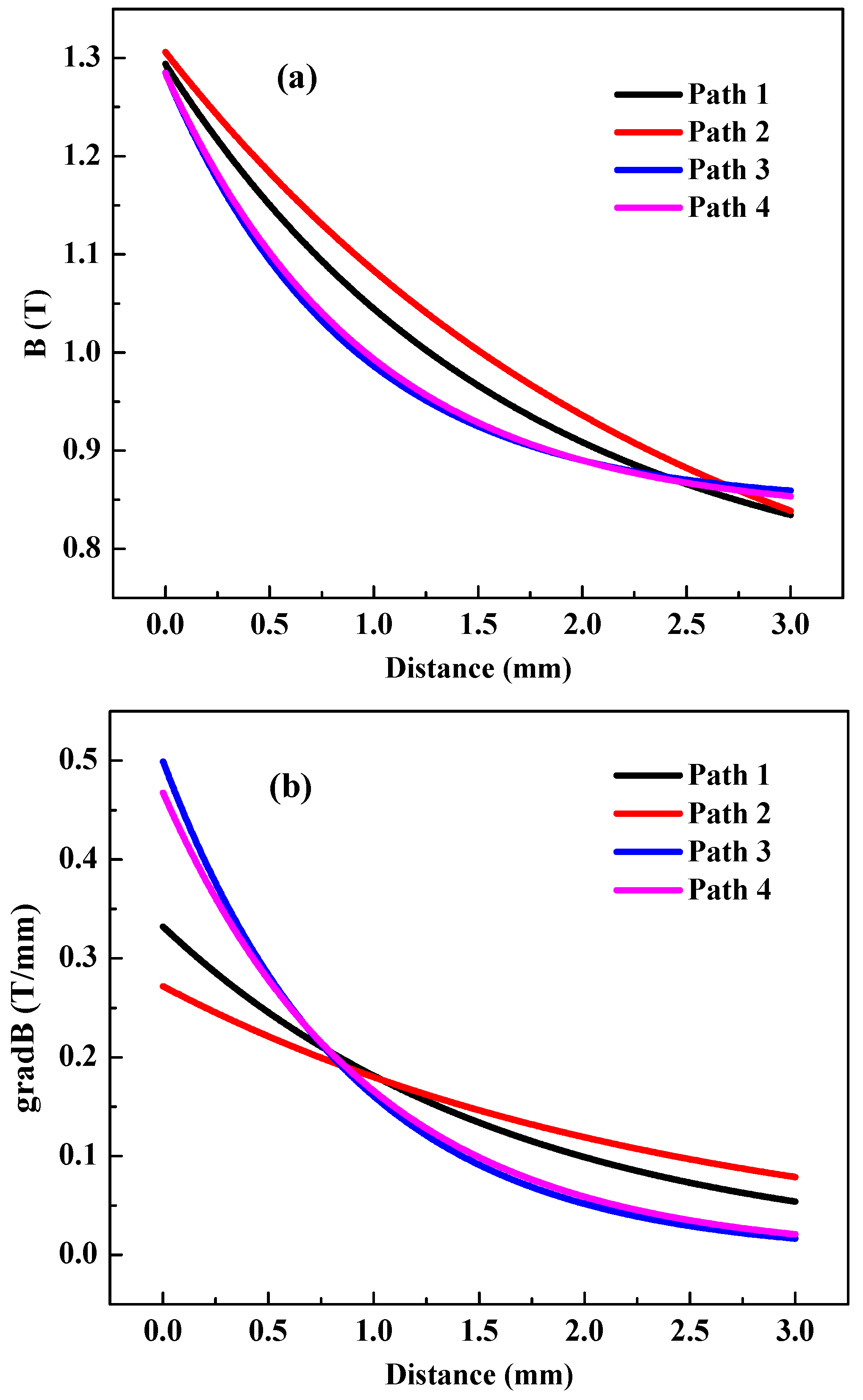
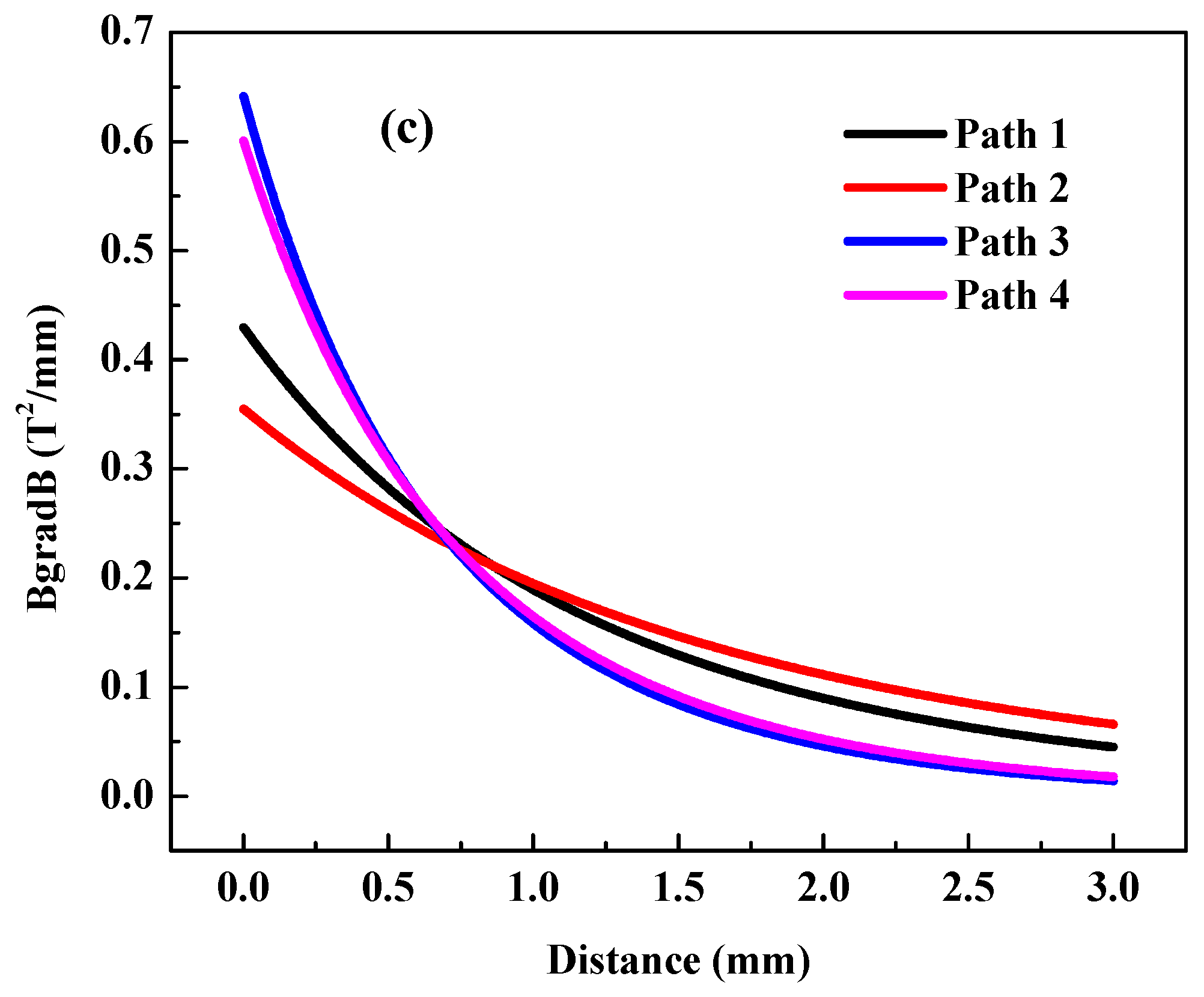
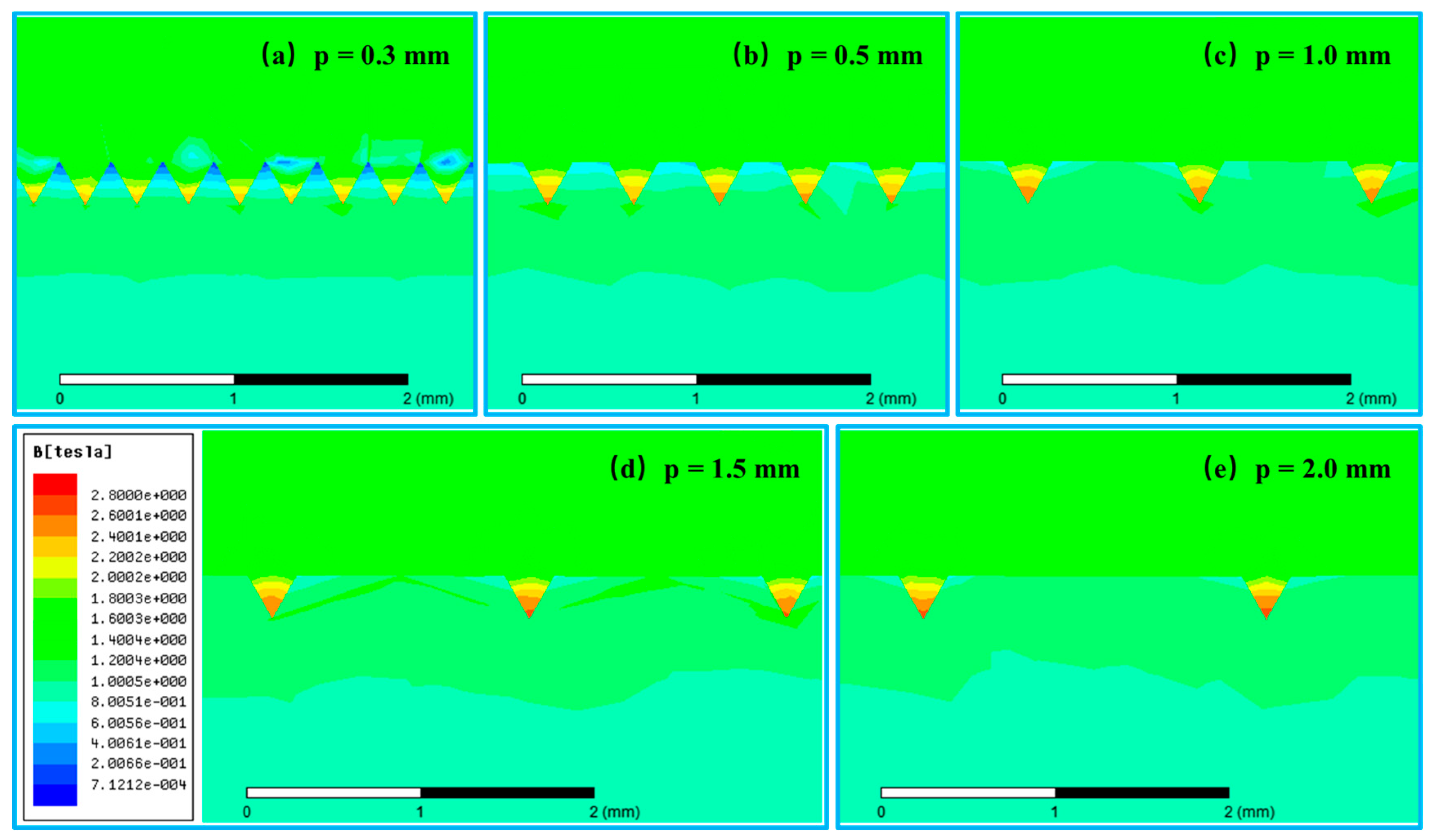
| Type of Parameters | Numerical Values |
|---|---|
| Magnetic field intensity (T) | 0.8 |
| Feed solid density (%) | 20 |
| Flowing speed of slurry (cm/s) | 4.39 |
| Output size (mm) | 10 |
| Pulsating stroke (mm) | 11.4 |
| Pulsating frequency (Hz) | 30 |
| Distance between ERB (mm) | p = 0, 0.5, 1.0, 1.5, 2.0 |
| Column gap in matrix (mm) | d = 2, 3, 4, 5 |
| Type of Parameters | Description |
|---|---|
| Material of ferrite yoke | Low carbon steel (Q235) |
| Material of exiting coils | Copper |
| Material of magnetic pole | Low carbon steel (Q235) |
| Material of matrix | Stainless steel (SUS430) |
| Separating zone | Vacuum |
| Gap between magnetic poles (mm) | 80 |
| Number of turns in the excitation coil | 300 |
| Magnetizing current (A) | 87 |
| Background magnetic induction (Tesla) | 0.8 |
© 2018 by the authors. Licensee MDPI, Basel, Switzerland. This article is an open access article distributed under the terms and conditions of the Creative Commons Attribution (CC BY) license (http://creativecommons.org/licenses/by/4.0/).
Share and Cite
Li, W.; Han, Y.; Xu, R.; Gong, E. A Preliminary Investigation into Separating Performance and Magnetic Field Characteristic Analysis Based on a Novel Matrix. Minerals 2018, 8, 94. https://doi.org/10.3390/min8030094
Li W, Han Y, Xu R, Gong E. A Preliminary Investigation into Separating Performance and Magnetic Field Characteristic Analysis Based on a Novel Matrix. Minerals. 2018; 8(3):94. https://doi.org/10.3390/min8030094
Chicago/Turabian StyleLi, Wenbo, Yuexin Han, Ruiqing Xu, and Enpu Gong. 2018. "A Preliminary Investigation into Separating Performance and Magnetic Field Characteristic Analysis Based on a Novel Matrix" Minerals 8, no. 3: 94. https://doi.org/10.3390/min8030094





